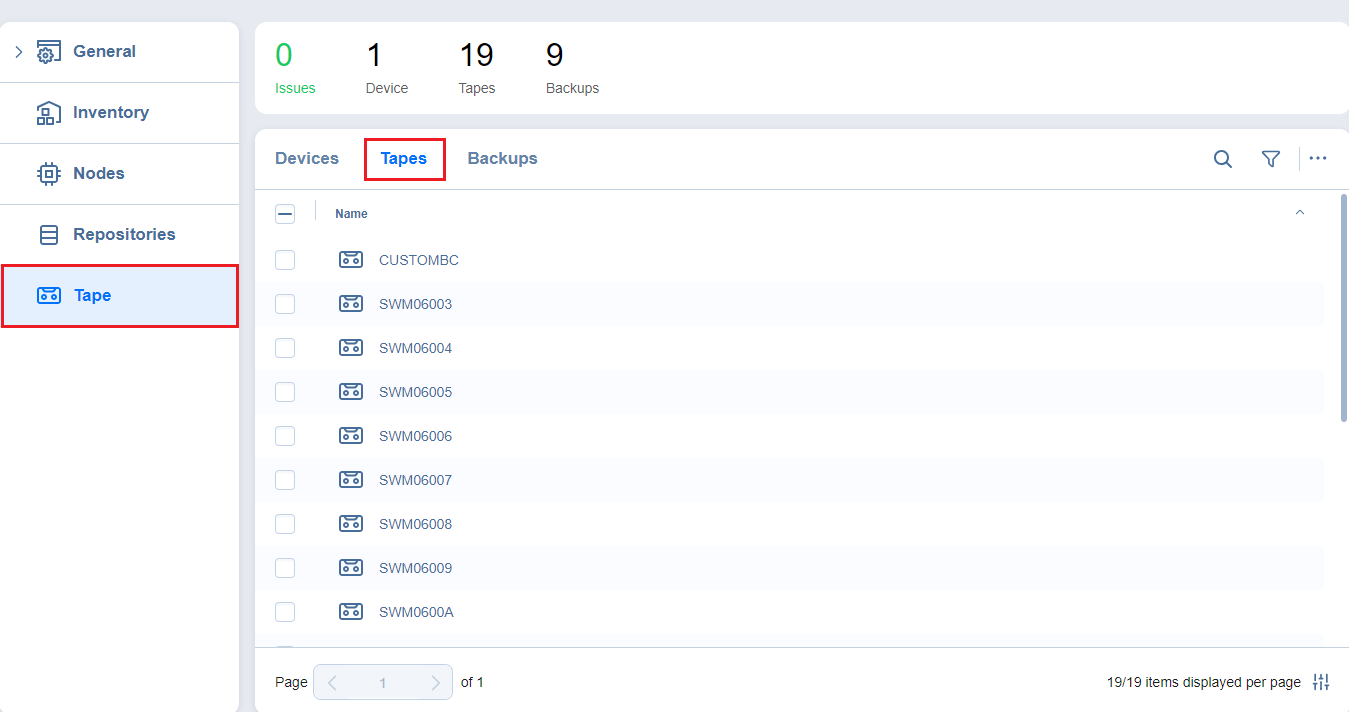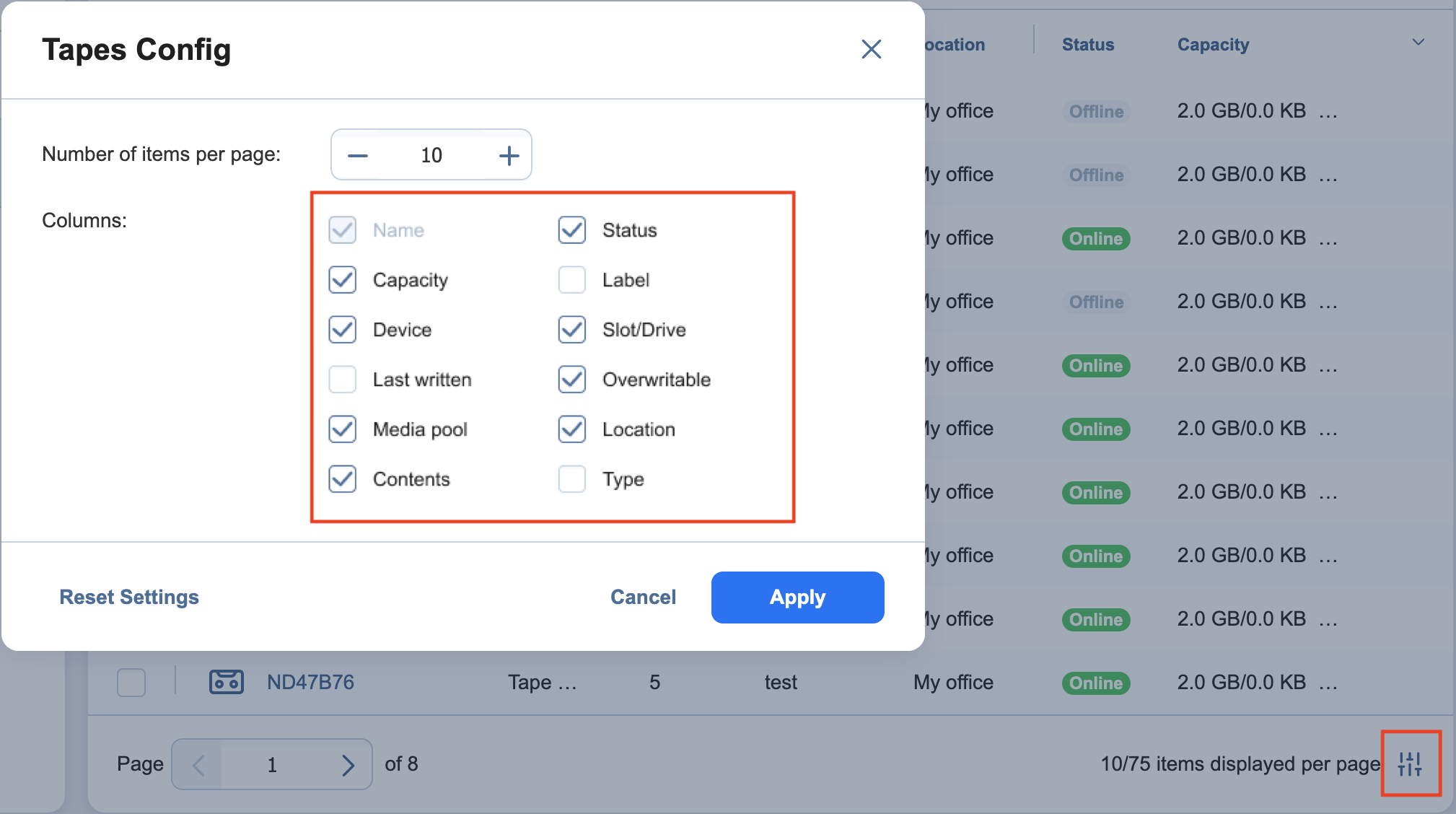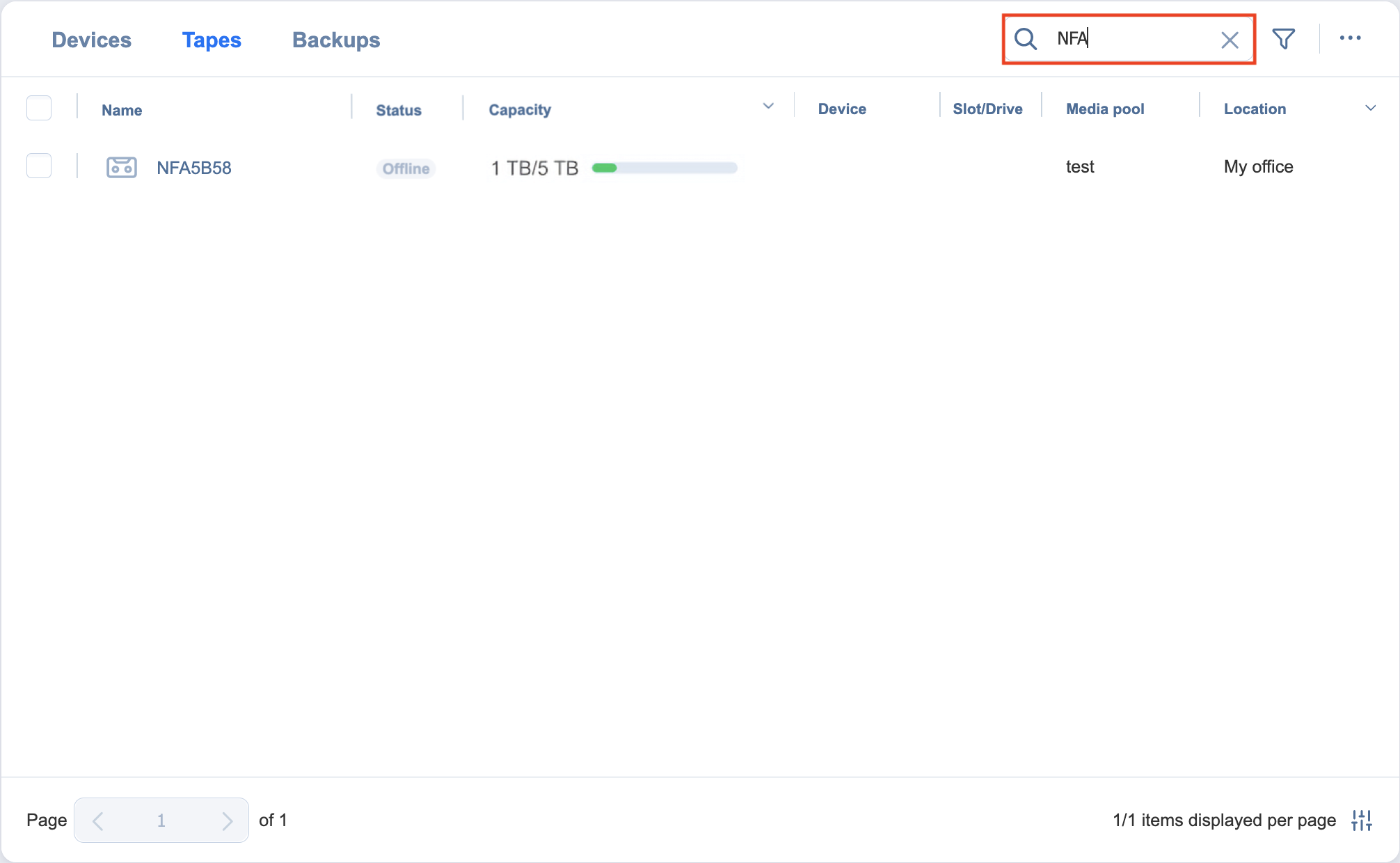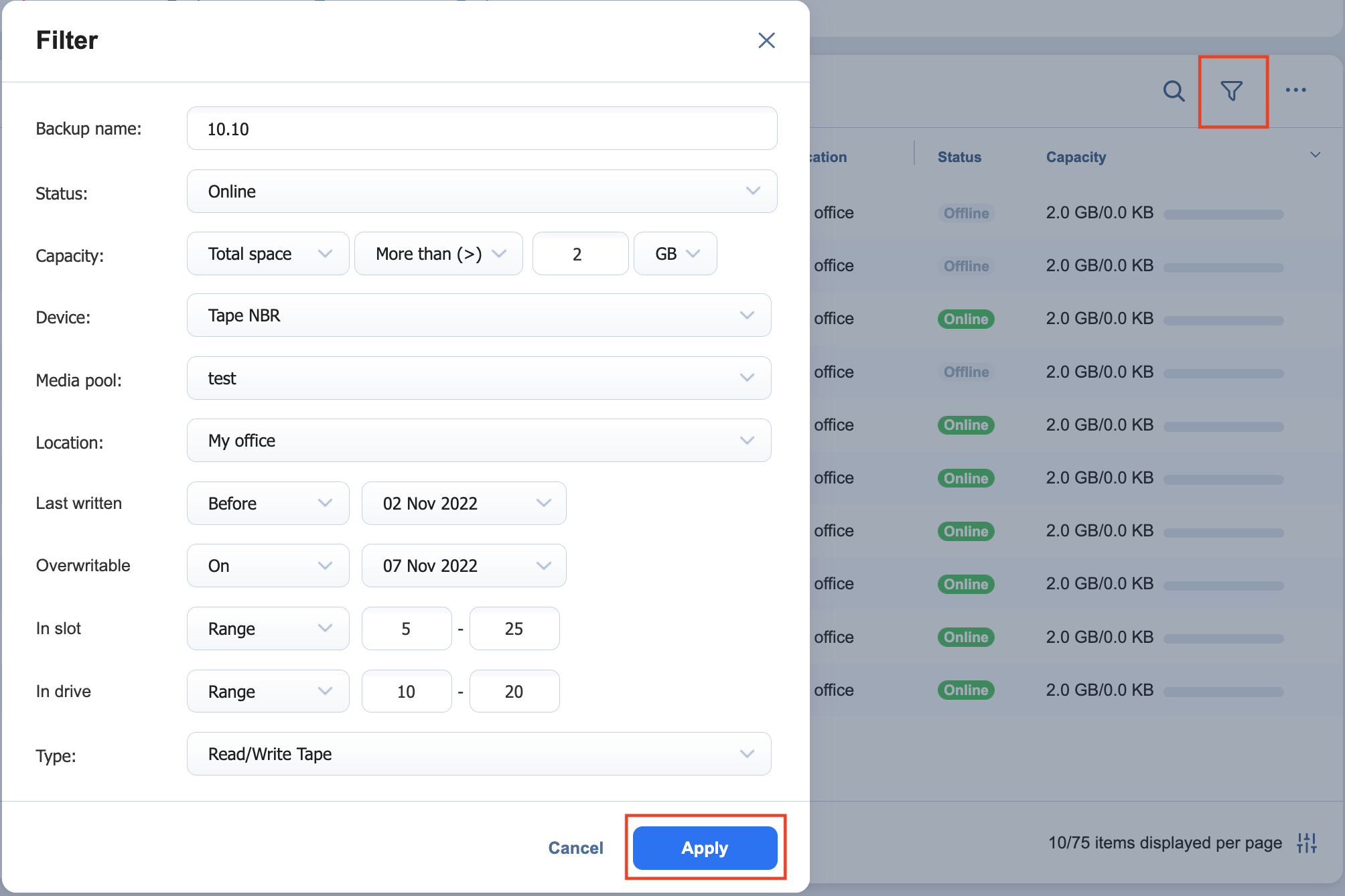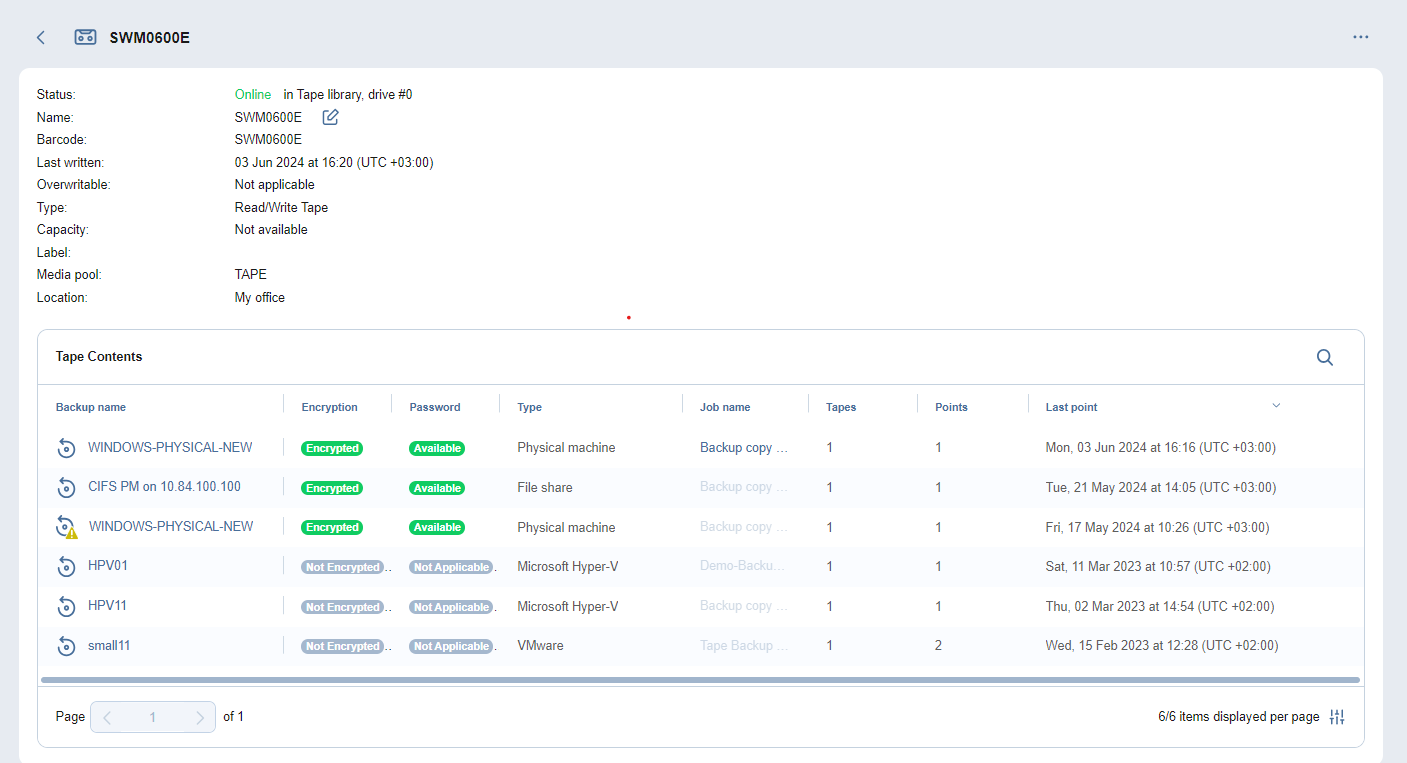Managing Tape Cartridges
The Tapes view allows you to view and manage all tape cartridges registered in the system. This section covers the following topics:
Viewing Tapes
To navigate to the Tapes menu, go to Settings > Tapes and click the Tapes tab.
The Tapes menu provides you with the following information about the tape cartridges in the table:
-
Name: Displays the tape cartridge name. Clicking the name opens the tape cartridge management page. For more information, see Tape Cartridge Management Page.
-
Label: Displays the label assigned to the tape cartridge ("none" for tape cartridges without labels)
-
Status: Displays the current status of the tape cartridge—Scanning / Online / Reading / Writing / Erasing / Warning / Error / Offline
-
Device: Displays the name of the tape device that contains the tape cartridge
-
Slot/Drive: Displays the slot/drive number of the tape cartridge
-
Last Written: Displays the date of the last recording on the tape cartridge
-
Overwritable: Displays the date when all recovery points on this tape cartridge will expire
-
Media Pool: Displays the name of the media pool that the tape cartridge belongs to
-
Location: Displays the name of the device location that the tape cartridge belongs to
-
Contents: Indicates the contents of the tape cartridge (e.g. number of backups on the tape cartridge)
-
Capacity: Displays the amount of free space relative to the total tape capacity. Hovering over this row also reveals the amount of used space. In case the capacity cannot be retrieved, Not available will be displayed instead.
Note
If hardware compression is enabled when writing data to a tape cartridge, NAKIVO Backup & Replication may display twice the amount of total, free, and used space.
-
-
Type: Displays the type of the tape cartridge:
-
Read/Write Tape
-
Write Protected Tape
-
Cleaning Tape
-
The column availability in the table can be managed by clicking the small config button in the bottom right of the table and checking/unchecking the boxes next to the column names.
Searching for Tape Cartridges
You can search for a specific tape cartridge by entering its name (or part of its name) into the Search box. The table will dynamically change to display the search results matching your query.
Clicking the Clear button in the search field will clear the query and the table will display all tape cartridges.
Filtering Tape Cartridges
The Tapes view also provides sophisticated filtering options that can be applied to search for particular tape cartridges. To access filtering options, click the Filter button next to the Search box. In the Filter pop-up, select one or several filtering criteria that will be applied with the AND statement.
You can apply the following filtering criteria:
-
Backup name: Tape cartridges containing the backups with the provided name will be displayed.
-
Status: Tape cartridges in one of the following statuses will be displayed:
-
Offline
-
Online
-
Scanning...
-
Erasing...
-
Cleaning...
-
Reading...
-
Writing...
-
Moving...
-
Warning
-
Error
-
-
Capacity: Filter by capacity by configuring the following options:
-
Select one of Total space, Free space, or Used space.
-
Select one of More than (>), Less than (<), or Equal to (=).
-
Enter a value corresponding to the desired capacity in GB or TB.
-
Select either GB or TB.
-
-
Device: Only the tape cartridges from the specified type device will be displayed.
-
Media Pool: Only the tape cartridges from the specified media pool will be displayed.
-
Location: Only the tape cartridges from the specified device location will be displayed.
-
Last Written: Displays the tape cartridges that have the data written to it on/before/after a specified date
-
Overwritable: Displays the date when the tape cartridge can be overwritten (calculated using the age and retention of all recovery points on this tape cartridge)
-
In Slot: Displays the tape cartridges in a specified slot or range of slots
-
In Drive: Displays the tape cartridges in a specified tape drive or range of tape drives
-
Type: Displays the tape cartridges according to their type:
-
Read/Write Tape
-
Write Protected Tape
-
Cleaning Tape
-
Note
The Search and Filter features can only be applied separately; you cannot simultaneously search for a tape cartridge by name and select filtering options.
Tape Cartridge Management Page
Clicking a tape cartridge name opens the tape cartridge management page where you can apply certain actions to the tape cartridge or get extensive information about it.
The tape cartridge management page consists of the following functional blocks:
Manage Options
The ellipsis Manage button allows you to perform particular actions with the tape cartridge. Depending on the tape cartridge state, type, status, etc., the button’s availability may vary. The button can be disabled if a certain action cannot be applied to the tape cartridge. Hovering over the disabled button displays a tooltip describing the reason for action unavailability.
Some of the actions can be applied to several tapes at once. For more information, refer to Bulk Tape Cartridge Management.
The following actions are available:
-
Scan: Scans the tape cartridge for its contents. The system recognizes the contents to be:
-
Known NAKIVO Backup & Replication backups: Such content requires no scanning. The backups contained on this tape cartridge are displayed in the Tape Cartridge Contents Table and can be used for VM restoring.
-
Unknown NAKIVO Backup & Replication backups: The system recognizes the contents as created by NAKIVO Backup & Replication (that is, on another product instance) but cannot be used for VM restores until scanned.
-
Empty: The tape cartridge contains no data and is ready to be used for backup.
-
Third Party Data: The tape cartridge contains some third party data that cannot be recognized by NAKIVO Backup & Replication. Such tape cartridges cannot be used unless their contents are erased.
-
Incomplete Backups: The tape cartridge contains incomplete backup(s), the result of an inappropriately finished backup job (for example, in the case that a backup copy job was stopped by the user and the backup copy was not completed). Incomplete backups cannot be used for recovery.
-
Unidentified: The contents of a newly introduced tape cartridge is unknown to the system and must be scanned first.
-
When you insert new tape cartridges into the tape device, and these tape cartridges contain backups created using another instance of NAKIVO Backup & Replication, the application opens the Scan new tape cartridges? notification box, asking if you'd like to scan the new tape cartridges. Clicking the Scan all link initiates the scanning action for all newly discovered tape cartridges.
-
Edit: Clicking the Edit button opens the Edit Tape dialog where you can:
-
Create or change a label for the tape for easier tape identifying
-
Assign the tape to a pre-created media pool
-
Allocate the tape to a pre-created location
The newly added details are displayed in the Options pane.
-
-
Move: This action allows you to move the tape cartridge to an available drive slot or tape drive. Occupied drive slots or tape drives are disabled in the menu.
-
Protect: Applying this action to the tape cartridge protects it from data overwriting. This action is only available on tape cartridges that contain recovery points. Recovery from protected tape cartridges is available. Protected tape cartridges can be reverted by clicking the Unprotect button. Clicking the Protect or Unprotect button requires confirmation.
-
Mark as free: Marking the tape cartridge as free makes it eligible for writing backups to it. Marking the tape cartridge as free does not erase the data right away: the next time the product needs a tape cartridge for writing data, it can take this tape cartridge and do a quick-erase before writing new data to it. The button is not available in case the tape cartridge is protected or empty. Marking the tape cartridge as free requires confirmation. The confirmation box displays detailed information about the data that is about to be deleted. This action cannot be undone.
-
Mark as cleaning: Specialized tape cartridges designed for tape drive cleaning need to be marked as cleaning tapes. For tape cartridges that have been marked as cleaning tapes, this option is replaced by the Mark as data button. Selecting Mark as data reverts a cleaning tape cartridge to a regular data tape cartridge.
Important
Currently, cleaning tapes inserted into a device are not automatically recognized by the system as cleaning. Instead, the system identifies the tapes to contain third party data. It is the user's responsibility to mark the tape as cleaning once the tape is inserted into the device and discovered. Otherwise, the cartridge will perform cleaning of the drive automatically every time the library is refreshed. -
Retire: The tape cartridges marked as retired will not be used for new backups. Recovery from retired tape cartridges is still available. The action is not available for tape cartridges marked as free or do not contain recovery points. This action requires confirmation.
-
Erase: The contents of the tape can be erased using:
-
Quick erase: The data is marked as deleted without actual data deletion. Such data can still be recovered if necessary.
-
Full erase: Deletes the data from the tape forever.
Keep in mind that both methods can be very time-consuming.
Clicking the Erase button opens the Erase selected tape? dialog providing detailed information about the data that is about to be deleted and allows choosing the erase method.
-
-
Clean drive: This action is only available for cartridges marked as cleaning. Select a drive from the drop-down menu and click Clean Drive to initiate the drive cleaning cycle and move the cleaning cartridge to the selected drive for cleaning.
-
Remove: Clicking this button will physically remove the tape cartridge from the tape device. The button is only available for the offline tape cartridges. The action requires your confirmation.
Details Pane
The Details pane provides full information about the tape:
-
Status: Displays the status of the tape cartridge and the current tape device name and drive slot/tape drive number. The tape cartridge can be in one of the following statuses: Scanning, Online, Reading, Writing, Erasing, Warning, Moving, Error, or Offline.
-
Name: Displays the name of the tape cartridge; can be modified by clicking the Edit button
-
Barcode: Displays the tape cartridge barcode if available
-
Last written: Displays the date of the last write operation
-
Overwritable: Displays the date when all recovery points on this tape cartridge expire
-
Type: Displays the type of the tape cartridge: Read/Write Tape, WORM Tape, Write Protected Tape, or Cleaning Tape
-
Capacity: Displays the amount of free space relative to the total tape capacity. Hovering over this row also reveals the amount of used space. In case the capacity cannot be retrieved, Not available will be displayed instead.
-
Label: Displays the tape cartridge label, if any
-
Media pool: Displays the assigned media pool, if any
-
Location: Displays the assigned location, if any
Tape Contents Table
The Tape Contents table provides information about the backups residing on the tape cartridge and allows for recovering VMs from backups right from the table. In case the tape cartridge contains no backups or has not yet been scanned, the table displays generic information about the tape cartridge contents, such as:
-
"This tape contains third party data."
-
"This tape cannot be identified. Scan the tape in order to discover its content."
-
"This tape is empty."
-
"This tape contains backups. Scan the tape to view the list of backups."
If the tape cartridge contains backups and has been scanned already, the Tape Contents table displays the backups and provides the following information:
-
Backup name: Displays the name of the backup. Clicking the name of the backup opens the Recovery page.
-
Type: Displays the type of a backup: VMware VM, Hyper-V VM or EC2 instance
-
Job: Displays the name of the last known job
-
Tapes: Shows the number of tape cartridges this backup is stored on
-
Points: Displays the number of recovery points in the backup
-
Last point: Displays the date of the most recent recovery point in the backup
The Tape Contents table can be modified to display the column you need by clicking the arrow icon in the table header and selecting the required columns.
Clicking the column's header sorts the contents of the column.
Backup Details
Clicking a backup name in the Tape Cartridge Contents table opens the Backup Details page where you can view the backup information and see all recovery points available for this backup. You can also initiate the recovery process from here.
The Backup Details section provides the following information about the backup:
-
Name: Displays the name of the backup
-
Type: Displays the type of backup: VMware VM, Hyper-V VM, EC2 instance or physical machine
-
Tapes: Displays the number of tape cartridges this backup is stored on
-
Recovery points: Displays the number of recovery points within the backup
-
First recovery point: Displays the date of the latest recovery point of the backup
-
Last recovery point: Displays the date of the most recent recovery point of the backup
-
Location: Displays the location the backup is assigned to
-
Job name: Displays the name of the job the backup belongs to
The Recovery points table lists all the recovery points available for the current backup and provides the following information:
-
Date: Indicates the date the recovery point was created. Clicking this parameter initiates recovery for this recovery point.
-
Type: Indicates the type of backup: Full or Incremental
-
Tape: Indicates the name of the tape cartridge the backup is stored on
-
Protected until: Indicates the date when the recovery point expires
Clicking either the Recover button or the date of the recovery point in the table opens the Recovery from Tape Wizard for the selected backup object. For more information about recovering from a tape cartridge, refer to Starting Recovery from Tape .
Bulk Tape Cartridge Management
Certain actions can be applied to several tape cartridges simultaneously. While in the Tapes tab, select the checkbox next to the tape cartridges you need to apply an action to and click the ellipsis Manage button. In the dialog box that opens, select an action to apply. Note that the availability of actions depends on various factors, so not all actions may be available. For action descriptions, refer to the Manage Options section above.
The Create report action is unique to the bulk tape cartridge management and is used to generate reports about selected tape cartridges. The report is created as a PDF file and is stored locally on your computer.
